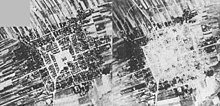Frampol
Frampol | |
|---|---|
 Town square | |
 Coat of arms | |
 Frampol | |
| Coordinates: 50°41′N 22°40′E / 50.683°N 22.667°E | |
| Country | |
| Voivodeship | Lublin |
| County | Biłgoraj |
| Gmina | Frampol |
| Government | |
| • Mayor | Tadeusz Niedźwiecki |
| Area | |
| • Total | 4.67 km2 (1.80 sq mi) |
| Elevation | 245 m (804 ft) |
| Population (2019) | |
| • Total | 1,433 |
| • Density | 310/km2 (790/sq mi) |
| Time zone | UTC+1 (CET) |
| • Summer (DST) | UTC+2 (CEST) |
| Postal code | 23–440 |
| Car plates | LBL |
| Website | http://www.frampol.pl |
Frampol [ˈframpɔl] is a town in Poland, in Biłgoraj County, Lublin Voivodeship. It has 1,440 inhabitants (2004), and lies in eastern Lesser Poland, near the Roztocze Upland. Frampol is surrounded by the Szczebrzeszyn Landscape Park and the Janów Lubelski Forest. The town is a junction of two local roads (the 74th and the 835th). The distance to Lublin is 68 kilometers.
The town was founded in 1717 by Count Marek Antoni Butler, with a unique, highly symmetric layout of streets in the shape of concentric rectangles around a large central square. Frampol lies in the area where once the village of Radzięcin existed. Its name, originally spelled Franopole, comes from Franciszka née Szczuka, the wife of Count Butler. In 1735, the Jewish community of Frampol already had its own cemetery, and in 1740, Józef Butler funded a wooden church, which since 1778 exists as a separate parish. In the second half of the 18th century, the town belonged to the Wisłocki family. It was an important center of artisans, mostly cloth makers, and like in other locations of eastern Poland, all houses were made of timber. Until 1795, Frampol belonged to Lublin Voivodeship, one of three regions of Lesser Poland. In 1795–1807 it was part of the Habsburg Empire, then it briefly belonged to the Duchy of Warsaw, which in 1815 was turned into Russian-controlled Congress Poland. In 1921, already in the Second Polish Republic, the population of Frampol was 2,720.
Currently, it is one of the smallest towns in Poland. In 1869 Frampol lost its official status as a town, to recover it only in 1993.
During World War II, 90% of the town's buildings were destroyed in a raid carried out by the Luftwaffe on September 13, 1939. During the German occupation, the town's significant Jewish community was murdered in the Holocaust. The town never fully recovered – its population today is less than half of what it was before the war. Frampol, or a fictionalized version thereof, is the setting of many of the best stories of Isaac Bashevis Singer, including Gimpel the Fool. Artist Irene Lieblich illustrated the Market of Frampol in Isaac Bashevis Singer's book 'A Tale of Three Wishes' from her direct memory of the marketplace of Frampol. This is the only known painting of the Frampol Marketplace as it existed before the full destruction by the German Luftwaffe.
See also[]

External links[]
- Official town website
- Description of Frampol in the Encyclopedia of Jewish Communities in Poland
- Description of the Jewish Cemetery in Frampol
| Wikimedia Commons has media related to Frampol. |
Coordinates: 50°40′25″N 22°40′05″E / 50.67361°N 22.66806°E
- Cities and towns in Lublin Voivodeship
- Biłgoraj County
- Lesser Poland
- Lublin Governorate
- Lublin Voivodeship (1919–1939)
- Populated places established in 1717
- 1717 establishments in the Polish–Lithuanian Commonwealth
- Holocaust locations in Poland

